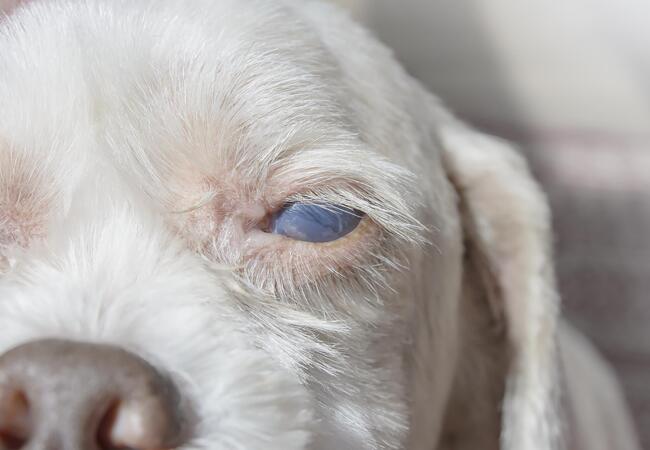Vet’s 2025 Guide to Canine Uveodermatologic Syndrome 🩺 Autoimmune Eye & Skin Outcomes

In this article
Vet’s 2025 Guide to Canine Uveodermatologic Syndrome 🩺 Autoimmune Eye & Skin Outcomes
By Dr. Duncan Houston BVSc
💡 What Is Uveodermatologic Syndrome?
Uveodermatologic syndrome (UDS), also known as Vogt–Koyanagi–Harada–like syndrome, is a rare autoimmune disorder in dogs where the immune system targets melanocytes—the pigment-producing cells in the eyes, skin, and hair—leading to destructive inflammation and depigmentation.
🌍 Who’s Affected & Why?
- Breeds at risk: Most common in Akitas, Siberian Huskies, Alaskan Malamutes, Samoyeds—but documented in many others such as Shetland Sheepdogs, Dachshunds, Golden Retrievers.
- Age & gender: Typically seen in dogs aged 6 months to 6 years; males may be at somewhat higher risk.
- Genetic predisposition: Strong heritable component; exact mode unknown.
- Potential triggers: May follow viral infection or sun exposure; autoimmune attack on melanocytes causes destructive uveitis and leukoderma.
👀 Clinical Signs & Progression
🔹 Ocular Signs (often first):
- Acute onset of painful, red, cloudy eyes—blepharospasm, photophobia, tearing.
- Panuveitis: iris abnormalities, aqueous flare, corneal edema, decreased pupillary reflex.
- Complications: glaucoma (seen in ~36% initially), cataracts, retinal detachment; ~57% blind at presentation.
- Retinal and choroidal depigmentation and inflammation may develop.
🔹 Dermatologic & Hair Changes (weeks to months later):
- Leukoderma and leukotrichia: whitening of skin/hair on nose, lips, eyelids, footpads, scrotum, anus, hard palate.
- May include crusting or ulceration on depigmented areas.
- Skin changes are cosmetic but support diagnosis and often follow ocular disease by 3–6 months.
🧪 Diagnosis & Differential
- History & breed predisposition: acute uveitis in risk breed with evolving skin depigmentation.
- Ophthalmic exam: detect flare, cells in the anterior chamber, corneal sensitivity, iris changes, IOP — screening for glaucoma.
- Dermatologic exam: inspect depigmented areas, biopsy lesional mucocutaneous site.
- Skin biopsy findings: lichenoid interface dermatitis with pigment incontinence and histiocytic infiltrate confirm UDS.
- Rule out other causes: vitiligo, cutaneous lupus, pemphigus, infectious uveitis, neoplasia.
- Systemic labs: CBC, biochem, urinalysis—usually unremarkable.
- Advanced diagnostics: ocular ultrasound or referral ophthalmologist for gonioscopy or retinal evaluation.
🛠 Treatment Protocol
Treatment goals: suppress immune-mediated inflammation, protect vision, manage skin disease.
1. Ocular Therapy
- Topical corticosteroids (e.g., prednisolone acetate q4–6h) to control anterior uveitis.
- Topical atropine/homatropine to relieve pain, prevent synechiae.
- Monitor for steroid-induced glaucoma—manage accordingly.
- Refer to an ophthalmologist for complications like cataracts or retinal detachment.
2. Systemic Immunosuppression
- High-dose prednisone (1–2 mg/kg/day), tapering slowly over weeks to months.
- Steroid-sparing agents: azathioprine, cyclosporine, leflunomide—added early to reduce steroid adverse effects.
- Consider topical or subconjunctival steroid injections for severe ocular inflammation.
3. Dermatologic Care
- Immunomodulators (like cyclosporine) may help maintain pigment and reduce flare ups.
- Topical emollients or antibiotics for ulcerated/crusted areas.
- Biopsy follow-up to assess histology if skin lesions recur.
4. Long‑Term Monitoring
- Frequent re-evaluations—ophthalmic exam every 2–4 weeks initially, then per response.
- IOP checks to prevent/manage glaucoma.
- Adjust meds based on flare-ups—lifelong therapy is often required.
- Monitor for steroid side effects—weight gain, hepatic changes, GI signs—modify dose as needed.
- Annual ocular specialist referral recommended for lifelong surveillance.
📈 Prognosis & Outcomes
- Vision: ~50% regain or maintain vision if diagnosed early; others may progress to permanent blindness—median time to blindness ~13.5 months if untreated.
- Skin: depigmentation is often permanent but non-painful; cosmetic impact only.
- Recurrences are common—lifelong therapy is usually indicated.
- Prognosis improves with early aggressive control of inflammation and close monitoring.
🚫 Breeding & Prevention Tips
- Do not breed affected dogs or their close relatives—heritable condition.
- Early signs of red eyes in at-risk breeds require prompt veterinary evaluation.
- Consider sun protection for Alaskan breeds to limit melanocyte triggering.
🏡 Ask A Vet App Home‑Support Tools
- 🗓 Track: medication schedules (topical/systemic), tapering reminders.
- 📊 Logs: vision tests, eye discharge, skin pigmentation updates.
- 📸 Upload photos: eyes and skin for remote vet review.
- 🔔 Alerts: detect flare-ups—redness, cloudiness, ulceration.
- 📚 Guides: eye-drop technique, sun protection, flare prevention.
🔑 Key Takeaways
- UDS is an autoimmune melanocyte-targeting disease affecting eyes and skin.
- Early aggressive steroid and immunomodulator therapy saves vision in ~50% of cases.
- Skin depigmentation is cosmetic; eye disease requires ongoing monitoring.
- Recurrences are common; lifelong management is often needed.
- Avoid breeding; monitor closely in predisposed breeds.
- Ask A Vet app provides structured tools for therapy adherence and early flare detection.
🩺 Final Thoughts ❤️
In 2025, canine uveodermatologic syndrome—though rare—demands immediate intervention to preserve vision. This multi-system autoimmune disorder requires immunosuppression guided by frequent specialty exams. While skin depigmentation is mostly cosmetic, complications like glaucoma or retinal detachment threaten sight. With prompt diagnosis, aggressive treatment, and vigilant follow-up enabled by tools like the Ask A Vet app, many dogs maintain quality of life and functional vision. Early recognition in high-risk breeds is essential. 🐾✨
Visit AskAVet.com and download the Ask A Vet app to schedule eye exams, log symptoms, set medication reminders, upload images of eyes/skin, and get expert guidance for managing flare-ups—right from your phone. 📲






